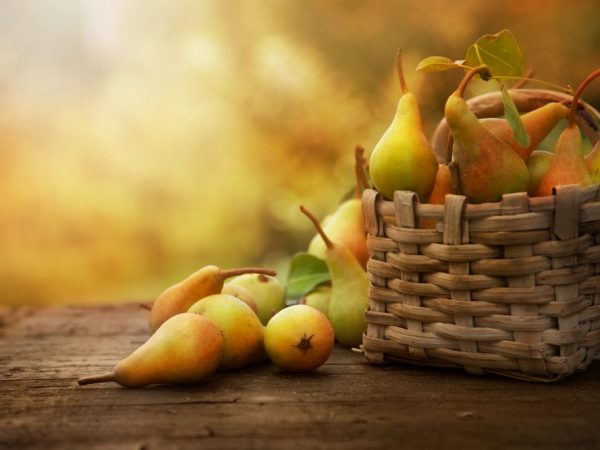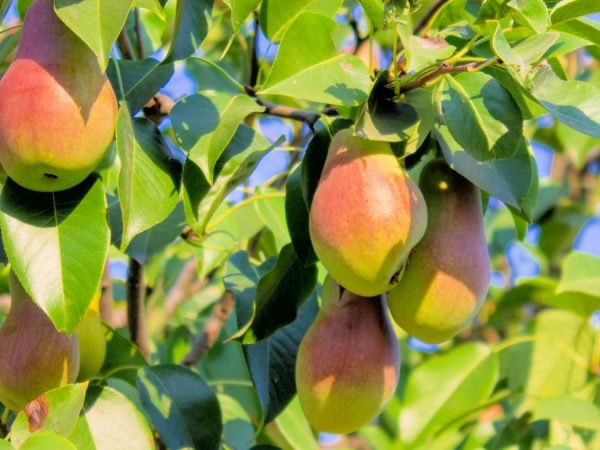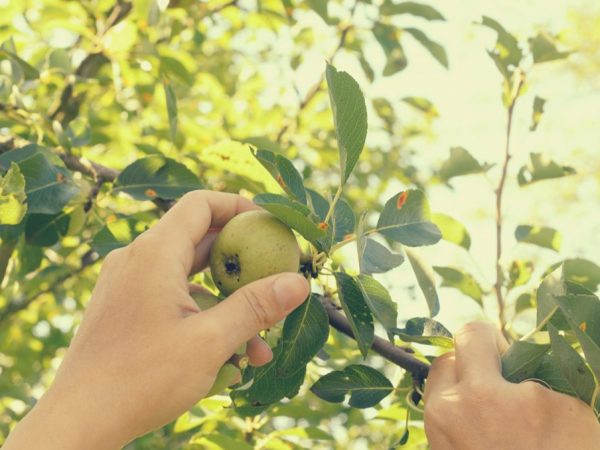Characteristics of the Santa Maria pear
The Santa Maria pear is an early autumn variety. The tree is resistant to cold weather, and the fruit has a delicate sweet taste. In the article, we will consider the description of the variety, the rules for planting and caring for it.

Characteristics of the Santa Maria pear
Characteristics of the variety
The Santa Maria pear is a hybrid variety. It combines 2 other varieties - Summer Duchess and Koschia.
According to gardeners, the fruit tree can easily endure winter. Pear is resistant to the following diseases:
- scab;
- low temperatures (down to -30 ° C);
- excessive waterlogging.
The Santa Maria tree bears harvest in mid-September. The yield is equal to 40 kg from 1 plant.
The fruit can be stored for about 2 months in a cool place or in the refrigerator. Thanks to their thick skin, they are excellent for transportation.
Description of the tree
The tree is medium-sized. Usually reaches 8-10 m in height. Begins to bear fruit quickly - in the 3rd year after planting.
Has medium thickening. When the pear grows up, the diameter of its crown is about 2-3 m.
The branches are directed upwards. Leaves are dark green with a slight sheen. During flowering, forms white flowers with 5 petals.
Description of fruits
The peculiarity of this pear is its delicate and pleasant taste. The fruit has a very juicy and tender yellow-white flesh. There is no granulation in the fruits of this variety. They are large, pear-shaped. The approximate weight is 200-250g.
Description of fruits:
- elongated;
- smooth;
- yellow-green with pink skin;
- remain firm even when ripe.

Fruits are smooth, large, weight is 200-250g
Santa Maria pears are often used to make jam and marmalade. They go well with quince in baked goods or baked goods. Canned pear compote can be given to children from 6 months. Pears can be eaten not only fresh, but also made from them jelly, jelly and so on.
How to plant a pear
Sapling selection
Gardeners are advised to take a responsible attitude to the choice of a seedling. They need to be carefully examined, especially the place of the cut rootstock. If it does not overgrow, then it is quite possible that the seedling is affected by a fungal disease.
Inspect for any damage near the bottom of the barrel. Choose smooth and even seedlings.
Pay attention to examining the root system. The fertility of the tree and the taste of the fruit depend on its condition. The less damaged the roots, the faster the seedling will take root. Another important characteristic is that the roots should not be dry when buying and planting.
Preparing for landing
In the southern region, the Santa Maria pear is planted in the fall. In the northern regions, it is necessary to plant the plant in the spring, since in winter it will freeze from extreme cold.
The next step is to prepare the landing site. This fruit tree loves to be warm, away from the wind and closer to the sun. The optimum temperature for planting is 15-20 ° C.
A pear does not tolerate excess moisture. It should be planted away from springs.The soil should be loose and have a minimum amount of clay. Sod soils are perfect.
A pit for a pear should be dug a week before planting. The optimum depth is approximately 50-60 cm, width is 1 m.
If necessary, you can drive a peg near the tree. It will be an additional support for a young seedling. The ground around you must be carefully tamped.
Santa Maria pear care
Top dressing
In spring, fruitful trees are the weakest, therefore they need good fertilization. It is important that fertilizers can be applied only after 2 years from the date of planting of the seedling.
Top dressing is carried out using nitrogen or complex fertilizers for the soil. They need to be brought into a specially dug trench around the seedling.
Fertilizers:
- Potassium. With its lack, brown spots appear on the leaves. The stem becomes weaker, the leaves curl into a tube. It contains substances that easily dissolve in water. It is better to fertilize before the autumn digging, since the elements will be absorbed faster from wet mail. Often this dressing is used with lime, because it has high acidity.
- Phosphorus. Gives the tree energy, controls metabolic processes. If you do not feed the tree with phosphorus fertilizers, it will lose its vegetative capacity. They are best applied in the fall. During the winter and spring, the roots will absorb the substances and the fruitfulness will improve in summer.
- Nitrogen. These fertilizers contribute to the compaction of the root system, the rapid development of fruits. Nitrogen pods should be applied in spring or late winter. It is very important not to overdo the dosage as this can reduce the yield of the tree.
In addition to mineral fertilizers, there is also organic fertilizing (for example, manure, compost). Manure should be laid in thin layers, between which superphosphate should be poured. If it is too dry, you can moisten it and sprinkle it with peat on top. For a tree up to 8 years old, about 30 kg of humus is needed, and for adults more than 45 kg.
Pruning
After wintering, do not forget about removing damaged and dry branches. Pruning can also be done to form a crown.
Gardeners distinguish the following pruning methods:
- Sparse tiered. After removal, the branches should be arranged in tiers. There should be at least 2-3 branches on one tier. The lower tier does not need to be touched.
- Semi-flat. The lower tier should have two opposite massive branches. The rest of the branches are sparsely located, about 40-50 cm.The height of such a tree will be about 3-5 m.
- Rounded fusiform. It is necessary to evenly place the side branches around the central trunk. The lower tier should consist of 6 branches. In all subsequent tiers, the number of branches should decrease.
It is worth cutting off damaged leaves. It is also advised to remove infected or rotten fruits.

After winter, you need to remove damaged and dry branches.
Watering
Watering plays an important role in maintenance. Moisturizing needs to be maintained regularly. About 2-3 buckets of water are enough for a year. The main thing is not to water near the trunk. The tree needs to be watered under the crown. Especially if there is no rain for a long time, and the ground under the tree is dry. About 1 bucket of water is enough to give moisture to the roots.
It is worth watering in the evening so that moisture lingers in the soil and reaches the root system.
Mulching
Mulching is covering the ground with bark, sawdust, straw, etc. This is done so that moisture does not evaporate from the soil.
A layer of mulch protects the plant from temperature changes, weeds and pests. It is best to mulch in the spring. But before that you need to make sure that the soil is moist and free of weeds.
Soil loosening
Loosening of the soil is done so that the air enters the soil better. Thanks to this action, water is absorbed much faster.
You need a hoe for loosening. It is better to do this by nudging the trunk circles in spring or autumn. Then you can walk with a pitchfork.
Pests
One of the most important pests for the Santa Maria pear is the gall midge.It feeds on leaves, sucking the juice out of them, and after that, growths form on them. For treatment, the pear must be sprayed with insecticides, the soil must be dug up, and the leaves must be destroyed.
Another pest that affects the pear is the pear honeydew. Its danger is as follows:
- in winter it lives in cracks in the bark;
- in spring and summer, it is located at the base of the kidneys;
- covers the leaves with a sticky liquid;
- makes undeveloped leaves;
- under its influence, the branches begin to dry out.
In the fight against copperhead, spray the pear with a manganese solution.
Fruit gall midge is another serious pest. The insect lives in the ovary of the fetus. When harvest time comes, some fruits dry out quickly due to strong deformation. To protect the tree from this insect, you need to spray it with insecticides before flowering.
Conclusion
Compliance with the basic agrotechnical measures will allow you to grow an excellent fruit tree. After 3 years, the gardener will be able to enjoy the fruits of Santa Maria.


